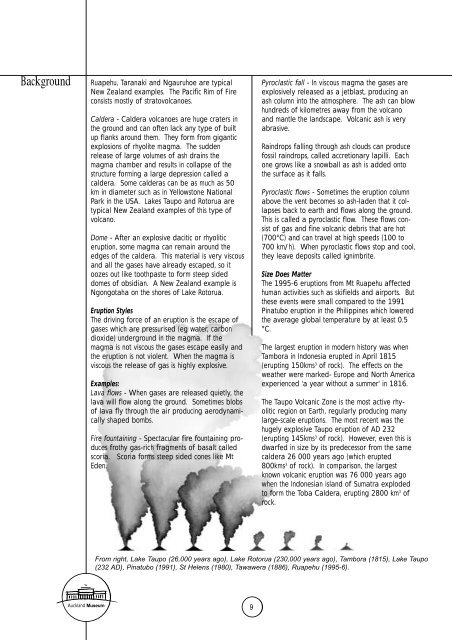Wanted: Oscar Obsidian - Auckland Museum
Wanted: Oscar Obsidian - Auckland Museum
Wanted: Oscar Obsidian - Auckland Museum
Create successful ePaper yourself
Turn your PDF publications into a flip-book with our unique Google optimized e-Paper software.
Background<br />
Ruapehu, Taranaki and Ngauruhoe are typical<br />
New Zealand examples. The Pacific Rim of Fire<br />
consists mostly of stratovolcanoes.<br />
Caldera - Caldera volcanoes are huge craters in<br />
the ground and can often lack any type of built<br />
up flanks around them. They form from gigantic<br />
explosions of rhyolite magma. The sudden<br />
release of large volumes of ash drains the<br />
magma chamber and results in collapse of the<br />
structure forming a large depression called a<br />
caldera. Some calderas can be as much as 50<br />
km in diameter such as in Yellowstone National<br />
Park in the USA. Lakes Taupo and Rotorua are<br />
typical New Zealand examples of this type of<br />
volcano.<br />
Dome - After an explosive dacitic or rhyolitic<br />
eruption, some magma can remain around the<br />
edges of the caldera. This material is very viscous<br />
and all the gases have already escaped, so it<br />
oozes out like toothpaste to form steep sided<br />
domes of obsidian. A New Zealand example is<br />
Ngongotaha on the shores of Lake Rotorua.<br />
Eruption Styles<br />
The driving force of an eruption is the escape of<br />
gases which are pressurised (eg water, carbon<br />
dioxide) underground in the magma. If the<br />
magma is not viscous the gases escape easily and<br />
the eruption is not violent. When the magma is<br />
viscous the release of gas is highly explosive.<br />
Examples:<br />
Lava flows - When gases are released quietly, the<br />
lava will flow along the ground. Sometimes blobs<br />
of lava fly through the air producing aerodynamically<br />
shaped bombs.<br />
Fire fountaining - Spectacular fire fountaining produces<br />
frothy gas-rich fragments of basalt called<br />
scoria. Scoria forms steep sided cones like Mt<br />
Eden.<br />
<strong>Auckland</strong> <strong>Museum</strong> 9<br />
Pyroclastic fall - In viscous magma the gases are<br />
explosively released as a jetblast, producing an<br />
ash column into the atmosphere. The ash can blow<br />
hundreds of kilometres away from the volcano<br />
and mantle the landscape. Volcanic ash is very<br />
abrasive.<br />
Raindrops falling through ash clouds can produce<br />
fossil raindrops, called accretionary lapilli. Each<br />
one grows like a snowball as ash is added onto<br />
the surface as it falls.<br />
Pyroclastic flows - Sometimes the eruption column<br />
above the vent becomes so ash-laden that it collapses<br />
back to earth and flows along the ground.<br />
This is called a pyroclastic flow. These flows consist<br />
of gas and fine volcanic debris that are hot<br />
(700°C) and can travel at high speeds (100 to<br />
700 km/h). When pyroclastic flows stop and cool,<br />
they leave deposits called ignimbrite.<br />
Size Does Matter<br />
The 1995-6 eruptions from Mt Ruapehu affected<br />
human activities such as skifields and airports. But<br />
these events were small compared to the 1991<br />
Pinatubo eruption in the Philippines which lowered<br />
the average global temperature by at least 0.5<br />
°C.<br />
The largest eruption in modern history was when<br />
Tambora in Indonesia erupted in April 1815<br />
(erupting 150kms 3 of rock). The effects on the<br />
weather were marked- Europe and North America<br />
experienced 'a year without a summer' in 1816.<br />
The Taupo Volcanic Zone is the most active rhyolitic<br />
region on Earth, regularly producing many<br />
large-scale eruptions. The most recent was the<br />
hugely explosive Taupo eruption of AD 232<br />
(erupting 145kms 3 of rock). However, even this is<br />
dwarfed in size by its predecessor from the same<br />
caldera 26 000 years ago (which erupted<br />
800kms 3 of rock). In comparison, the largest<br />
known volcanic eruption was 76 000 years ago<br />
when the Indonesian island of Sumatra exploded<br />
to form the Toba Caldera, erupting 2800 km 3 of<br />
rock.<br />
From right, Lake Taupo (26,000 years ago), Lake Rotorua (230,000 years ago), Tambora (1815), Lake Taupo<br />
(232 AD), Pinatubo (1991), St Helens (1980), Tawawera (1886), Ruapehu (1995-6).











